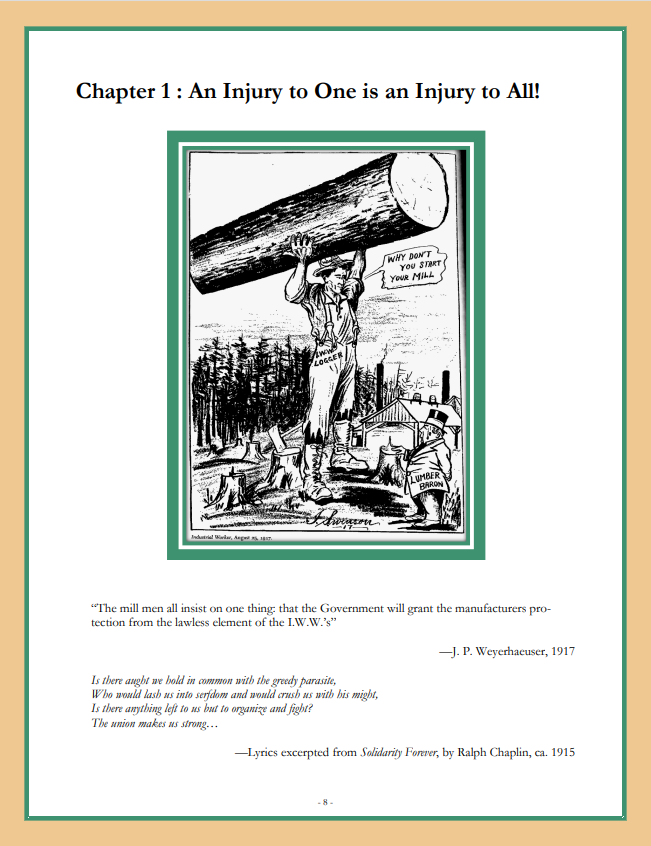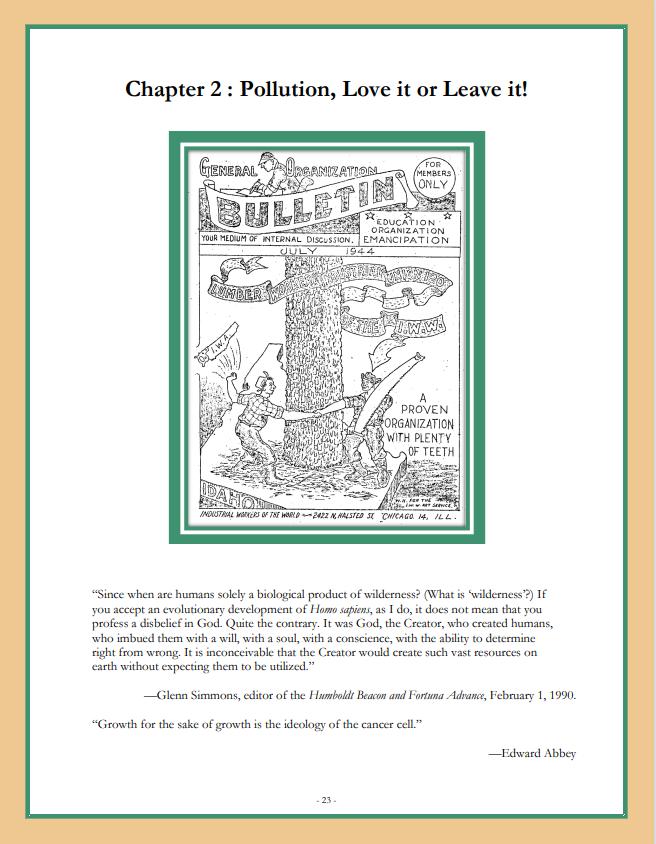By Steve Ongerth - From the book, Redwood Uprising: Book 1
Download a free PDF version of this chapter.
The mill men all insist on one thing: that the Government will grant the manufacturers protection from the lawless element of the I.W.W.’s”
—J. P. Weyerhaeuser, 1917
Is there aught we hold in common with the greedy parasite,
Who would lash us into serfdom and would crush us with his might,
Is there anything left to us but to organize and fight?
The union makes us strong…
—Lyrics excerpted from Solidarity Forever, by Ralph Chaplin, ca. 1915
The timber industry has, throughout nearly its entire history, been in the control of an elite minority of the very rich and powerful, and they have been especially avaricious, violent, and repressive towards all who would challenge their power. They have also—in spite of a barrage of slick propaganda trumpeting their careful management of the resource—depleted most of the virgin forests of the Pacific Northwest. Many environmental organizations can trace their origins to opposition to such practices, and in the struggles by environmentalists to preserve forestlands, timber workers have had a reputation for being their fiercest adversaries, and in many cases, this is true. Timber workers have a well deserved reputation for being outspoken about the pride of purpose in their job, as well as a deeply ingrained cultural machismo. Yet lumber harvesting and production is historically one of the ten most dangerous jobs in the industrialized world, and timber workers are among those most exploited by their employers. One would logically expect the timber workers to be highly resistant to such treatment, but in recent years they haven’t been. This wasn’t always so. To understand why, one must examine the industry’s origins.
Before the arrival of European-American settlers to the Pacific Northwest, the entire region stretching from northern California to Canada and Alaska from the Pacific Coast to the Rocky Mountains was dominated by coniferous old growth forests. At least 20 million acres of this land was forested, dominated by various species of trees, some of them hundreds of feet in height, over a dozen feet in diameter, and centuries or even millennia old.[1] In the southwestern part of this region, stretching from Big Sur to roughly what is now the Oregon state line, in a belt that was at least twenty miles wide for most of its expanse a very unique species of tree dominated, Sequoia sempervirens, commonly known as the California redwoods, some of them standing over 350 feet tall. Their close (and similarly large) cousins, Sequoiadendron giganteum, better known as the Giant Sequoia, only grew in a few isolated spots in the southern end of the Sierra Nevada foothills. These vast forests were far more then the trees, however. Hundreds, if not thousands of plant and animal species lived and flourished within these wooded habitats, and as far as is known, the indigenous population of the Americas had no significant lasting impact on California’s ancient redwood forests, nor did they have any lasting effect on the timberlands of the Pacific Northwest in general.[2] Like the Native Americans, the old growth forests of the Pacific Northwest had remained left more or less untouched for thousands, if not hundreds of thousands of years.
The coming of the white man changed all of that. The Russians first began exploiting the redwoods for the construction of Fort Ross in 1812, during their very brief settlement there.[3] As more Europeans arrived, the forests south of San Francisco were the first to be logged, usually through clearcutting, until these ancient stands were completely liquidated by 1860. In those days, loggers used hand saws, and felling an ancient redwood could take anywhere from two-to-five days to complete. The redwoods to the north of the Golden Gate in what is now Marin County were logged next, especially along rivers that allowed easy transportation by the available modes of the day. By this time, around 1881, the steam engine had replaced pack animals. Though this first wave of automation did not have a significant impact on the number of workers involved in the logging process, it greatly increased the impact logging had on the redwoods. Entire forests were liquidated, no matter how small the tree, because even the baby trees were used to build the skid roads used for hauling the larger ones. These forests were never replanted, and very few of them grew back, and in some cases, farmlands replaced them. By the beginning of the 20th Century, all but a few of these ancient trees were gone and logging operations migrated north to Sonoma County. One quarter century later, most of these old growth forests were likewise gone.[4]






 Hydrogen is touted as the next big thing for non- carbon energy and energy storage. Yet when we look at the facts, it’s not that simple.
Hydrogen is touted as the next big thing for non- carbon energy and energy storage. Yet when we look at the facts, it’s not that simple.
